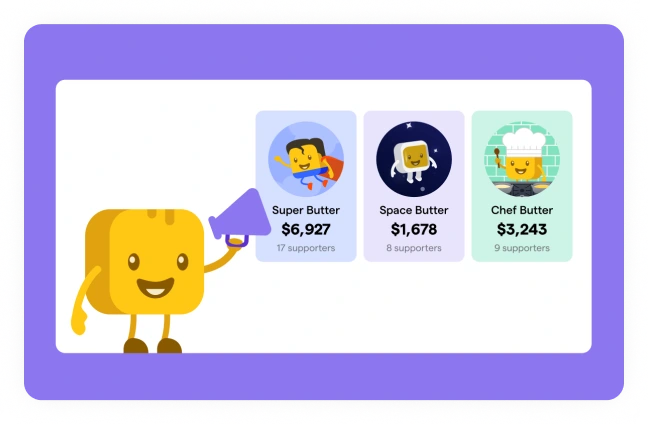Table of contents
Table of contents
If your nonprofit is eager to engage new supporters and make a bigger impact than ever before, peer-to-peer fundraising might be the solution for you.
Whether you’re thinking about launching your first peer-to-peer campaign or looking to enhance your existing efforts, we’ll share best practices and the five steps you need for success. Plus, we’ve got a free downloadable toolkit to help you and your team get the ball rolling.
Download your free peer-to-peer fundraising toolkit
Whether you're a first-timer or looking to improve your P2P chops, this guide covers all the basics and best practices for planning a successful campaign.
What is peer-to-peer fundraising?
Let’s start with the peer-to-peer fundraising definition! Peer-to-peer fundraising, also known as “peer 2 peer” fundraising or “P2P,” empowers supporters to raise money on behalf of a nonprofit by rallying their social circles and personal connections.
In P2P campaigns, individuals personalize their own fundraising pages, or they can create or join a team fundraising effort and compete against other groups to raise the most money for the cause.
What is the difference between peer-to-peer fundraising and crowdfunding?
While similar in nature, crowdfunding and peer-to-peer fundraising have key differences.
Crowdfunding is an umbrella term for social fundraising, where an individual, group, or organization solicits donations from their wider social network to reach a fundraising goal. These campaigns are typically managed on a single fundraising page by one entity (e.g., a person, club, or nonprofit) and usually have time parameters (e.g., “Help us raise $1K in 30 days!”).
Like crowdfunding, peer-to-peer fundraising is often time-bound and garners support from social networks—a donor base, friends, family, colleagues, former clients, etc. However, P2P campaigns involve not just one but several different fundraising pages led by individuals and groups, all connected to a central nonprofit fundraising initiative.
Benefits of peer-to-peer fundraising
P2P fundraising can have a massive impact.
In 2023 alone, the top peer-to-peer fundraising programs in the United States raised $1.1B in collective revenue. By 2024, revenue grew by 3% for the top 20 peer-to-peer fundraising campaigns. Let’s explore some key reasons why nonprofits choose this fundraising strategy.
Peer-to-peer fundraising can…
✅ Create friendly competition: P2P campaigns often raise funds quickly because they add gamification with team leaderboards, individual fundraising goals, and fundraising thermometers.
✅ Save time and money: People who participate in P2P campaigns are volunteer fundraisers, which can reduce costs and save time for you and your staff.
✅ Expand your network: Every peer-to-peer or team fundraiser participant opens the door to new networks of potential donors for your organization.
✅ Empower your supporters: A P2P campaign allows your most passionate, engaged followers to become advocates, strengthening your relationships and their commitment to your cause.
✅ Build a movement: In his Mobilizing Funds Webinar, Fundraising Expert, Floyd Jones describes:
I see P2P and movement building as one and the same. It’s not just about the funds. It’s about who you’re partnering with to propel your movement forward. The fastest way to ignite the movement and gather momentum for your cause is peer-to-peer fundraising.
What are the disadvantages of peer-to-peer fundraising?
Of course, like with any fundraising tactic, there are a few potential challenges of peer-to-peer fundraising to consider before diving in headfirst.
Cons of P2P fundraising may include the following:
❌ Individuals can get lost: Sometimes, an individual fundraiser does not follow through on their commitment to raise a certain amount of funds. When you’re on a team, it can be easy to hide behind everyone else.
💡Solution: Encourage participants to set individual goals as part of the team’s goal. Use automated reminders and group check-ins to help members stay motivated and engaged.
❌ Difficult to manage: Without the right tools, nonprofits can find it challenging to provide the infrastructure team fundraisers need for success.
💡Solution: Utilize a robust peer-to-peer fundraising platform to easily manage volunteers and track fundraising progress.
❌ Leaders don’t always take responsibility: As much as a nonprofit might equip a team leader, that individual may not have the bandwidth or know-how to follow through.
💡Solution: Provide realistic, measurable, and easy-to-understand training before they begin. The more guidance you give early on, the more successful they will be!
❌ Difficult to bring supporters on board: Setting up a personal fundraising page might be intimidating for anyone new to this kind of campaign.
💡Solution: Keep it simple! Givebutter’s user-friendly tools, including peer-to-peer and team fundraising, allow anyone to sign up and create their own personalized P2P pages in minutes.
Givebutter includes essential features such as auctions, peer-to-peer fundraising, CRM data, and customizable fundraising all in one package. Overall, Givebutter is an A+ package with A+ staff. — Givebutter review, Michelle P.
How to create a peer-to-peer fundraising campaign
Launching a successful peer-to-peer campaign is all about nailing the strategy and execution. Follow these five key steps to maximize your impact.
Step 1: Set clear, achievable goals 🎯
Like with any successful fundraiser, the first step involves setting SMART fundraising goals (specific, measurable, achievable, relevant, and time-bound). This will help keep your event focused and effective.
- Specific: Clearly define what you want to achieve—e.g., raise $75K.
- Measurable: Determine what metrics you’ll track to measure success—e.g., number of fundraisers recruited, total funds raised, and average amount raised per fundraiser.
- Achievable: Set realistic goals based on past performance—e.g., aim for a 20% increase in donations from last year.
- Relevant: Ensure your goals align with your mission—e.g., funds will directly support four programs that our animal shelter runs.
- Time-bound: Set a campaign timeline—e.g., our P2P campaign will run for six weeks, from September 1 to October 15.
Step 2: Assemble your team 💪
P2P fundraisers have a lot of moving parts—far too many for just one person to handle. Plan to assign staff and volunteers to assist with every part of the campaign, such as:
- Campaign Manager: Oversees the entire campaign from start to finish, including setting timelines, making high-level decisions about the fundraiser, and coordinating with all departments.
- Marketing Coordinator: Handles all print and digital advertising, including the campaign's overall messaging strategy and branding.
- Sponsorship Lead: Identifies and reaches out to potential corporate sponsors, creates sponsorship levels, and manages relationships.
- Volunteer Coordinator: Recruits and trains individual fundraisers, provides ongoing support and motivation to participants, and creates fundraising toolkits and resources.
- Donor Stewardship Lead: Develops and implements donor communication strategies, follows up with major donors, oversees donor recognition, etc.
Step 3: Get the right tools 🧰
A lot of the people you’ll engage in a P2P campaign aren’t fundraisers themselves. You’ll need to make it easy for the fundraiser to reach out and bring other people on. Make a toolkit with approved language and graphics that fundraisers can copy and paste. Whatever software you’re utilizing, make it incredibly easy for people to get involved. — Mobilizing Funds webinar, Floyd Jones
Selecting the right peer-to-peer fundraising platform is essential for effectively reaching out to your network via social media, email, text messages, and more.
Start by assessing your goals and budget. And most importantly, make sure the platform has the key features you need, including:
- Individual and team fundraising features 👥
- Personalized pages with custom links 👩
- Leaderboards 🏆
- Easy social sharing 🗣️
- Peer-to-peer texting 📱
- Supporter feed 👋
- Donation tracking 🤓
💥 Pro tip: With peer-to-peer fundraising, it’s essential to use a simple and easily shareable fundraising tool. The goal is always to keep things as simple as possible for your fundraisers.
The best part of Givebutter is how easy it is to learn, as well as how customizable the peer-to-peer campaigns are. It’s great for big peer-to-peer campaigns or just to collect donations. I also really appreciate the CRM features, which are great if you have ongoing or recurring fundraisers. — Givebutter review, Silas L.
When you sign up for a free Givebutter account, you gain access to top-notch Givebutter peer-to-peer fundraising tools and a collection of highly rated fundraising solutions. On top of that, Givebutter offers a built-in CRM, event pages, and email marketing tools, allowing you to easily engage new donors, communicate with your P2P fundraisers, and track campaign progress—all in one place, for free.

Start peer-to-peer fundraising with Givebutter
Step 4: Rally the troops 📣
To set your campaign up for success, recruit a team of enthusiastic P2P fundraisers and encourage them to create their own custom campaign pages. These pages will help them spread the word through social media, text, and email.
Step 5: Blast off 🚀
Set your team up for success by sharing key fundraising resources, including a donation request letter, high-quality images and videos that highlight your cause, and fundraising FAQs.
Track your P2P fundraisers' progress, share updates, provide tips, answer questions, and express gratitude throughout the campaign.
Get started with these peer-to-peer fundraising ideas
When it comes to hosting a successful peer-to-peer fundraiser, the possibilities are endless. What matters most is creating an event that excites and motivates your target audience.
Here are a few P2P fundraising ideas to help get your wheels turning:
- Fitness events like 5Ks, dance marathons, and basketball shoot-a-thons 🏋
- Contests and tournaments like trivia, game nights, or golf tournaments 🏆
- Unique social challenges like No Shave November 🥸
- Merchandise sales like t-shirts or gourmet cookies 🍪
- Corporate matching gift campaigns 💰
💥 Pro tip: Foster friendly competition and recognize your donors! For example, give a special social media shoutout to the first team to sell 20 event tickets or secure a $500 corporate sponsorship.
9 peer-to-peer fundraising best practices
As the nonprofit behind a P2P campaign, your role is to ensure that both individual and team fundraisers have a seamless experience from start to finish.
Beyond making the process fun, they need to feel supported and prepared. Equip them with the right tools, resources (like images or logos), and communication scripts to get them started.
Here are some top peer-to-peer fundraising tips that will set your fundraisers up for success.
1. Recruit all-star fundraisers ⭐
Target your most dedicated and active stakeholders, such as your board of directors. Don’t forget to check if these leaders have connections to companies that match donations so your fundraisers can double their impact.
2. Help teams pick a theme ☁️
Letting teams choose what they want to do is usually the best route, but sometimes, they need help figuring out where to start. Share a list of ideas or send them links to past team fundraisers so they can get going quickly.
3. Advise participants to set team and individual goals 🥅
Ask each fundraiser what they think is a reasonable goal. If they’re unsure, provide an idea of what similar-sized teams have raised for your nonprofit in the past to help them gauge what’s achievable.
4. Recommend timelines ⏰
To help teams estimate a realistic timeframe for reaching their goals, consider their previous fundraising experience and current availability. Keep in mind that higher goals typically require more time to achieve, so be sure to factor that in.
5. Guide teams on how to tell their stories 📖
Writing a personal fundraising story on the campaign page is usually the most intimidating part for new fundraisers. Make it easier on them by providing templated copy and examples.
6. Ask teams to commit to the first donation 🤑
Explain how making a donation to their own page can help individuals and teams kickstart their fundraising progress, giving them momentum right out of the gate.
7. Coach teams through the ‘ask’ 🤔
Create a short, step-by-step guide that teaches your teams how to ask for donations. You can even provide a communication script or email template to make this as easy as possible for them.
8. Share updates 👍
Share regular updates with teams on their progress (such as, "We've hit 75% of our fundraising goal and only have two days left. Please help us cross the finish line!"), and call out the top fundraisers.
Additionally, encourage your fundraisers to share their own updates with their supporters at least every five days—this tactic makes campaigns three times more successful!
9. Celebrate your teams 🎉
In addition to thanking everyone who donated, thank every team member via email and with a handwritten letter or personalized video from your leadership. Personal touches go a long way!
3 successful P2P fundraising examples in action
Ready to start planning your next peer-to-peer fundraiser? Check out these real-life campaigns from awesome nonprofits in the Givebutter community:
1. Fostering Great Ideas

💛 Why we love this peer-to-peer fundraising example: Fostering Great Ideas, an organization focused on improving foster care, used peer-to-peer fundraising as one of their key fundraising tactics.
Along with matching donation opportunities and raffle ticket sales, they surpassed their initial goal!
💰 Raised: $166K+
💪 How you can do it: Create a campaign with a defined end time (e.g., ten days) and offer supporters multiple ways to contribute (team fundraising, auction participation, social sharing, etc.).
2. Hope Creek Academy
_page-0002.jpg)
💛 Why we love this P2P fundraising example: This school for neurodivergent children rallied its community with a team fundraising campaign that sparked friendly competition between school groups—middle school, staff, high school, and more.
💰 Raised: $94K+
💪 How you can do it: Inspire fundraisers to join your campaign by gamifying it and building on existing groups to foster a fun, competitive spirit!
3. L-CMD Research Foundation
_page-0003.jpg)
💛 Why we love this peer-to-peer fundraiser: To help fund various stages of a gene therapy project for LMNA-related congenital muscular dystrophy (L-CMD), this campaign leveraged emotional storytelling and social media to reach its goal.
💰 Raised: $2M+
💪 How you can do it: Use powerful peer-to-peer fundraising software to manage and streamline all your fundraising efforts in one dashboard. This makes it easier to engage supporters through storytelling and social media, just as this campaign did to reach its impressive goal.
Start peer-to-peer fundraising for free with Givebutter
Peer-to-peer fundraising campaigns empower your supporters to take action, raise money, and spread the word to attract new donors. They also enable you to build relationships with people in your fundraisers’ networks, helping them stay engaged and continue supporting your cause long after the campaign ends.
Givebutter provides all the tools you need to successfully launch a peer-to-peer campaign. This all-in-one platform comes complete with donation forms, fundraising pages, event management, auctions, a built-in CRM, and marketing tools—all for free.
Ready to see how Givebutter can help you raise more for your mission? Sign up for free and get started today!
Peer-to-peer fundraising FAQs
What’s the difference between crowdfunding and peer-to-peer fundraising?
Crowdfunding and peer-to-peer fundraising are similar, with one key difference: In a P2P fundraising campaign, each fundraiser has their own giving page. In a crowdfunding campaign, the giving page is centralized and usually monitored by the nonprofit.
How can we make sure fundraisers actually participate?
Offer toolkits, regular check-ins, and celebrate their progress—people are more likely to stay engaged when they feel supported and recognized.
How long should a peer-to-peer campaign run?
Most successful campaigns last 2–6 weeks. Long enough to build momentum, but short enough to keep urgency high.
Is peer-to-peer fundraising just for big nonprofit organizations?
Not at all—small and mid-sized organizations can often see the biggest impact because of their close relationships with supporters.
.svg)






%20(1).png)



.svg)















